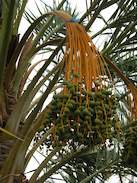
Scientific name: Phoenix dactylifera
Common Name: Date Palm
Plant Description
The Date pal tree can reach about 20 metres in height, growing as a single stem or if left and not pruned and cleaned at the base will form a bush of several stems from the same root system.
The leaves are about 4 metres long, with spines at the base nearest the stem, and will bear about 100+ leaflets. The leaflets are 25 to 35 cm long and about 2 to 3 cm wide.
Date Uses
Dates are eaten fresh and are used in baking and cooking. They are also used in shakes and other drinks.
Soil Requirements and Preparation
Date palms can be grown in a wide range of soils. From sandy soils to light clays. They can also tolerate higher salinity in soil and water. The pH of the soil should preferably be between 6 and 7.5.
Clear the area to be planted of weeds and level. The soil from the plant holes of (1mx1mx1m) should be mixed with about 15Kg compost and or manure. About one kilogram of Superphosphate or MaxiFos and about 2 kilograms of 3:1:5 (26) about 10Kg of Gypsum can be mixed into the soil to combat soil salinity if required.
Climate
Most Dates are produced in arid and semi-arid regions. They do however require large amounts of water when produced commercially.
Date Cultivars
The most popular variety in South Africa is the Medjool Date.
Other popular varieties are Barhi, Deglet Noor, Sayer and Zahdi.